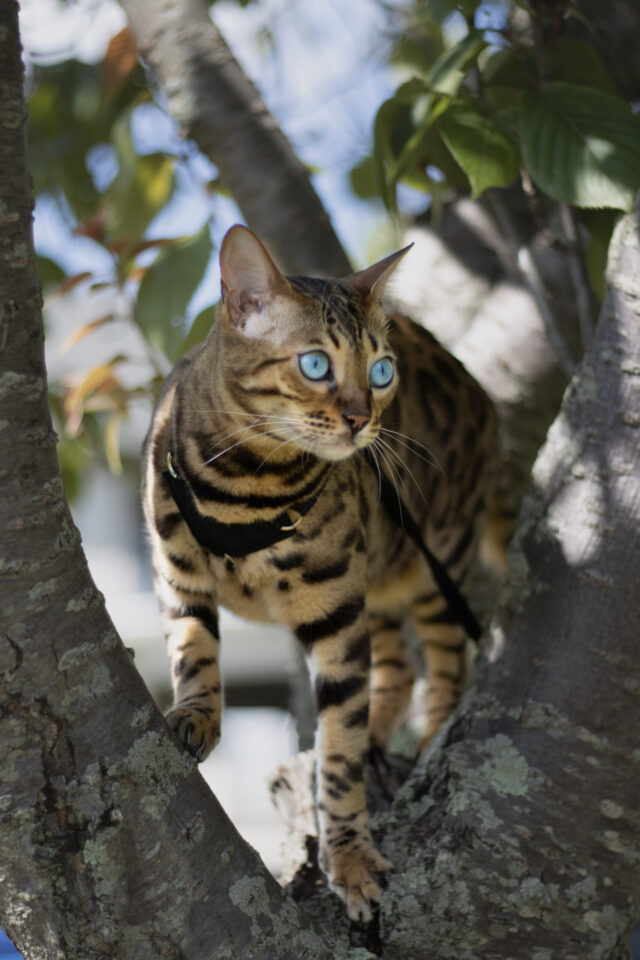Teaching your cat to walk on a harness may seem challenging, but it’s actually a straightforward process that requires some patience and time. Some kitties may take to it quickly, especially if they have a craving for adventure like Mia the Bengal cat.
When Albert met Mia, he knew she needed more than indoor playtime to burn off her excess energy. As a dedicated paw parent, he taught Mia to wear a harness so they could enjoy the great outdoors together. After just a few training sessions, Mia was ready to explore the world, allowing Albert to take her to places he never imagined.
If you and your cat are an adventurous duo like Albert and Mia, you’ll soon be able to teach your cat how to walk on a harness with these simple steps. Taking your cat outside for some fun can provide numerous benefits for their well-being.

Three Reasons to Walk Your Cat
While not all cats may be interested in wearing a harness and going for walks, high-energy cats often enjoy it because they need and crave the activity. Mia thrives on life with a harness, and Albert has noticed three benefits from teaching her to walk on a leash.
#1 – Harnessing Up Can Unleash Curiosity
Exploring the outdoors activates a cat’s natural hunting instincts and curiosity. Allowing them to unleash their wild side helps them thrive in various aspects of their lives.
#2 – Drain Your Little Big Cat’s Energy
Cats love to explore and going outside gives them plenty of space to investigate. They spend time sniffing around and investigating, giving their instincts and energy levels a chance to shine. Whether they’re exploring a hole in the ground or a tree for a vantage point, your furry explorer will use all their senses to take it all in. After some running around, you’ll have a tired out kitty on your hands – a cat who gets plenty of stimulation and exercise is a happy one!
#3 – Together Time Deepens Your Bond
Walking your cat on a leash not only provides exercise and stimulation but also strengthens the bond between you and your cat. After outdoor adventures, your cat will likely be ready for a nap. And their favorite spot to sleep is curled up in your arms, making snuggle time even more bonding!

Teach Your Cat To Walk On A Harness
When teaching your cat to walk on a leash, follow these four simple but essential steps:
- Choose the right harness.
- Desensitize your cat to the harness.
- Put on the harness.
- Walk your cat on a leash.
And remember, rewarding your cat with a treat for a job well done is crucial for successful harness training!
Choose the Right Harness
When looking for a harness for your cat, be prepared for a wide range of options. While not all may be suitable, there is a harness out there for every cat. Make sure to find the right size to ensure a comfortable fit – a harness that’s too big can lead to escapes, while one that’s too small can cause discomfort. Measure your cat and refer to the manufacturer’s guidelines for sizing.
If you’re unsure which harness to choose, consider the OutdoorBengal Escape-Proof Cat Harness. It’s lightweight and secure, making escape nearly impossible.

Desensitize Your Cat to the Harness
Cats may not always be receptive to new items, so it’s essential to desensitize them to the harness. Allow your cat to familiarize themselves with the harness by placing it in areas they frequent, letting them scent it. Praise your cat for investigating the harness and offer treats to create positive associations. Take your time and proceed at your cat’s pace.
It’s important to be patient and consistent during the training process, and soon enough, your cat will be ready to enjoy walks on a harness with you!
Start off on the right foot with your cat by taking your time and not rushing the process of introducing them to a new harness. The goal is to make it a fun experience for both you and your feline friend, so be patient and gentle.
To begin, it’s time to put the harness on your cat. If your cat knows how to sit and stay, that’s the easiest way to do it. If not, you can secure your cat’s rump between your elbow and body while using both hands to strap them into the harness. It may take some practice, but eventually your cat will get used to wearing the harness.
Once your cat is comfortable with the harness, it’s time to add the leash. Start indoors to get your cat used to being guided by the leash before venturing outdoors. Choose a quiet spot initially, and gradually introduce more populated areas as your cat becomes more comfortable.
Remember, habituation is key. Keep sessions short and positive to help your cat get used to the harness and leash. With time and patience, you and your cat will be ready for all sorts of adventures together.
If you’re looking for a high-quality harness for your cat, consider the OutdoorBengal Escape-Proof Cat Harness. It’s a great option for outdoor excursions with your feline companion. And who knows, you might even run into Albert and Mia out there too! following sentence:
Original: “She was unable to attend the meeting due to a prior commitment.”
Rewritten: “Due to a prior commitment, she was unable to attend the meeting.”

